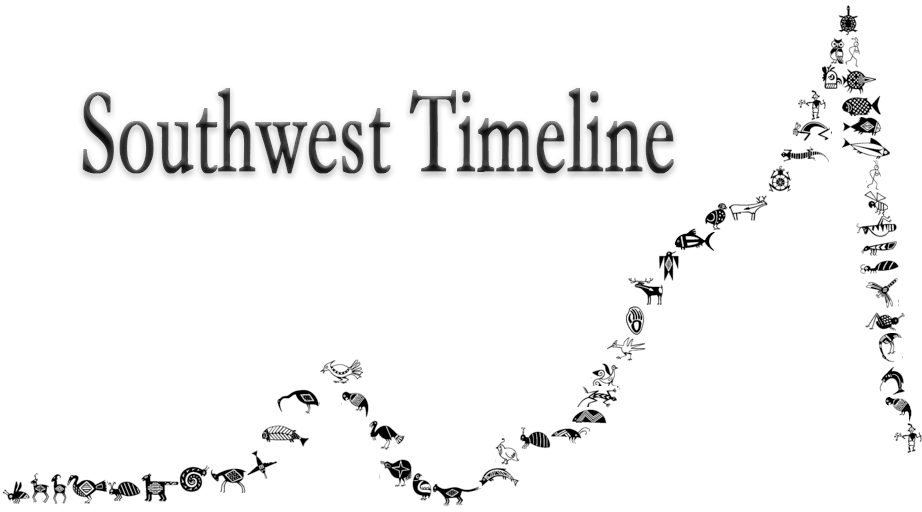

40,000 to 15,000 B.P.
There may or may not have been humans spreading into the New World long, long ago. Interpretation of archaeological evidence in this period is like looking “for ghosts in a dense fog.”
15,000 to 13,500 B.P. Pre-Clovis
Humans may have came to the Americas at about this period if not before, but evidence disputable. The early Paleoindians, assuming some came from east Asia, were nomadic small game hunter-gatherers living in extended family bands, maybe two dozen members from children to grandparents, that moved across the landscape in response to the rhythm of the seasons and the availability of resources. Carrying their belongings, they traveled by foot to scatter widely throughout the Americas. They took shelter where they could find it, sometimes in rocky depressions, or built rudimentary brush and skin shelters when they didn't just sleep in the open. They clothed their bodies with animal skins and plant fibers.
13,500 to 12,700 B.P., Clovis Period
Asiatic immigrants came to the Americas with atlatl spear tech to hunt big game and prospered, their population pulsed exponentially for a time. Megafauna extinction (12,900 B.P.) in Southwest: gomphothere, mastodon, mammoth, Pleistocene musk-ox, caribou, long-horned bison, horse, tapir, ground sloth, camel, mountain goat, and dire wolf.
12,700 to 8,500 B.P., Folsom, Plainview-Plano Period
Smaller spear points used to hunt remaining bison.
10,000 B.P., Archaic–Early Basketmaker Era (8,000 BCE to 1,200 BCE)
The pre-Pueblo/Anasazi culture moved into the modern-day Southwestern United States after the big game hunters departed. Little evidence for extensive habitation before 8000 BCE exists. From evidence near Navajo Mountain, they were nomadic people, hunter-gatherers traveling in small bands. They gathered wild foods when in season, and hunted with stone-tipped spears, atlatls, and darts. Game included rabbits, deer, antelope, and bighorn sheep.
There was a trend toward a sedentary lifestyle, with small-scale cultivation of plants beginning about 2,100 BCE.
8,500 to 5,000 B.P., Desert Archaic Period
Hunter-gatherers in increasingly arid period. Artifacts of hunter-gatherers suggests that people concentrated on hunting and gathering of locally available game and food, often living near canyon heads.
5,000 to 2,750 B.P., Sub-Boreal Period
Cooler and moister climate, hunter-gatherer ways transition to agrarian.
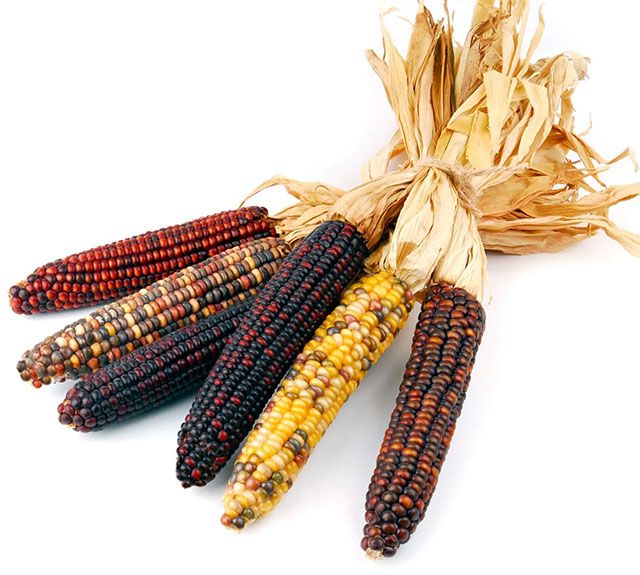
3,750 to 2,750 B.P., Armijo phase
Cultivation of maize at seasonal sites of up to 50 people. Mesoamerican corn, if not Mesoamericans themselves, came to the Southwest about 2100 BCE.
2,750 B.P. to Present, Sub-Atlantic Period, return to arid climate.
2,750 to 1,550 B.P., En Medio phase
Increase in the number of sites, but generally at the base of cliffs, and the introduction of the use of storage pits for surplus food. It was roughly analogous to the southwestern Basketmaker culture.
2,200 to 1,950 B.P. (250 BCE – 1 CE) Early Basketmaker II Era, 1200 BCE to 1 CE.
The early Anasazi camped in the open or lived in caves seasonally. During this period, they began to cultivate gardens of maize (flint corn in particular) and squash, but no beans. They used manos and metates to grind corn, and the women made baskets for numerous uses. They had no pottery.
1,950 to 1,450 B.P. (1 to 500 CE) Late Basketmaker II Era
The people constructed primitive storage bins, cists, and shallow pit-houses. At this stage, evidence suggests that the beginning of a religious and decision-making structure had already developed. Shamanistic cults existed, and petroglyphs and other rock art indicate a ceremonial structure as well. Groups appear to be increasingly linked into larger-scale decision-making bodies.
1,550 to 1,350 B.P (400 to 650 CE), Trujillo phase
Pottery was introduced from Mesoamerica during this period. The spread of Mesoamericans and/or culture, their agricultural ways, trade items, and ideas into the Southwest became the Pueblo culture today's Hopi are direct decedents of.
500 to 750 CE, Basketmaker III Era
Deep pithouses were developed, along with some above-ground rooms. The bow and arrow replace the atlatl and spear. Plain bisque and some painted black-on-white pottery is made. Cultivation of beans begins, available due to trade from Central America, and edible due to slow cooking in pottery vessels. Wild amaranth and pinyon pine were also staples. People of this era may have domesticated turkeys. The prototype kivas were large, round, and subterranean with both domestic and ceremonial uses. The mesa today's Hopi farm was occupied at this time by them and continues to be dryland farmed sustainably on an average 9.9 inches of rainfall, a unique achievement in the Americas.
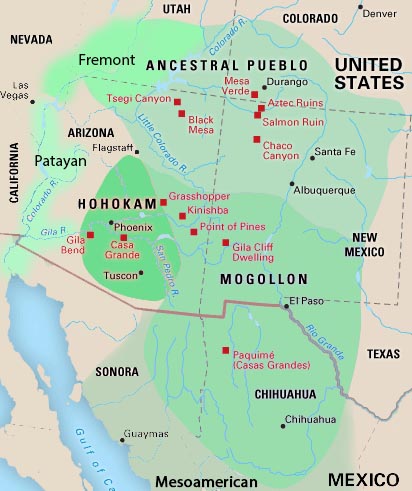
750 to 900 CE, Pueblo I Era
The Pueblo I Era saw increasing populations, growing village size, social integration, and more complicated and complex agricultural systems typified this era. The construction and year-round occupation of pueblos begins; the people constructed reservoirs and canals to deal with scarce and irregular water resources. Large villages and great kivas appear, though pithouses still remain in use. Above-ground construction is of jacal or crude masonry. Plain gray bisque predominates in pottery, though some red bisque and pottery decorated in black and white appears.
900 to 1150 CE, Pueblo II Era
By 1050, Chaco Canyon (in present-day New Mexico) was a major regional center, with a population of 1,500–5,000 people. It is surrounded by standardized planned towns, or great houses, built from the wood of more than 200,000 trees. Thirty-foot-wide (9.1 m) roads, flanked by berms, radiate from Chaco in various directions. Small blocks of above-ground masonry rooms and a kiva make up a typical pueblo. Great kivas were up to 50–70 feet (15–21 m) in diameter. Pottery consists of corrugated gray bisque and decorated black-on-white in addition to some decorated red and orange vessels. The people imported shells and turquoise from other cultures through trading. During the 12th century, populations began to grow after a decline at the end of the Pueblo II Era. More intense agriculture was characteristic, with terracing and irrigation common. Evidence of cannibalism associated with Chaco region 900-1300 CE, a likely Mesoamerican import.
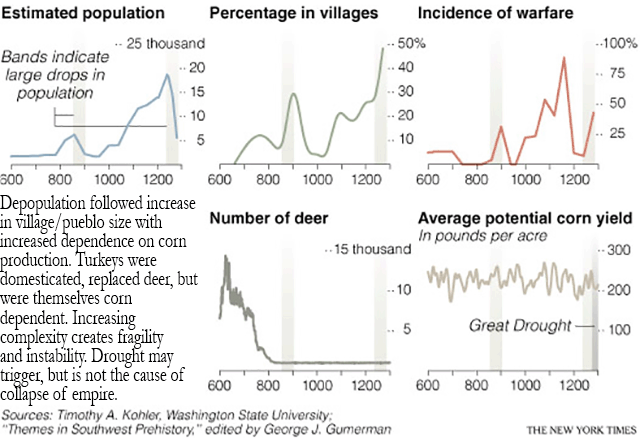
Data for Village Ecodynamics Project study area
Note: Puebloan corn yield, dryland with low rainfall, was about 4 bushels corn per acre and consumption may have been about 350 lbs/person/year (1,800 calories corn/day) which would require 1.6 acres corn/beans/squash per person. In Midwest area of US with adequate rainfall, corn yield in 19th century averaged 26 bushels per acre as it may have for the Cahokians who were contemporary with the Puebloans. Today, with virtually unlimited fossil fuel inputs into the production system: herbicides, pesticides, high fertilizer application, full mechanization, hybridized seed, irrigation as needed....the corn cultivars developed to maximize grain production without needing to survive sub-optimal conditions due to the optimal conditions industrial agribusiness provides using high energy inputs, yield is about 150 bu/ac. With only sun and rain inputs, and human/animal labor, yield may once again be up to 4 to 26 bushels per acre assuming needed know-how is reacquired and seeds of adapted cultivars are available.
The other import was social stratification, social hierarchy, the development of religious and political elites to rule over commoners and the empire-building that goes with elite interests. The ruins that typify Pueblo culture today were centers of elite control within a sea of agricultural villages. The Hopi farmed marginal lands on the outskirts of Pueblo Empire and retained their self-reliance, largely free from distant elite control, and continued a commitment to social equality where rank does not have extreme privileges. Of today's 12 villages on the Hopi Nation, six refuse to send representatives to the tribal government, founded in 1936, as rule from outside is irrelevant.
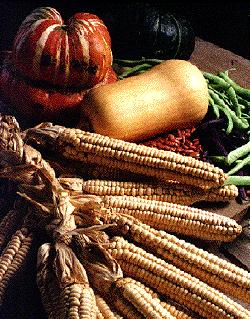
1150 to 1350 CE, Pueblo III Era
Settlements consist of large pueblos, cliff dwellings, towers and turkey pens. Most villages in the Four Corners area are abandoned by AD1300. The distinction between the Hohokam and Ancient Pueblo people becomes blurred.
The Chaco Canyon center of power and control stopped growing by 1125 CE and elites moved to Mesa Verde area to rebuild empire on new ground. The Mesa Verde population grew until many elites were living in pueblos dependent on outlying small agricultural settlements. Over 40,000 people lived in the Mesa Verde area at its peak, but the area was depopulated by 1290 CE.
1350 to 1600 CE, Pueblo IV Era
Typically, large remaining pueblos in the Southwest are centered around a plaza. Socially, this was a period of more conflict than cooperation. The people began making kachinas for religious and ritual purposes. Plain pottery supplants corrugated. Red, orange and yellow pottery is on the rise as the black-on-white declines. Cotton is introduced and grown as a commodity.
The Puebloans are joined by other cultures. As early as the 15th century, the Navajo were in the process of migrating into the region from the north. In the next century, the Spanish colonists first came in the 1540s from the south.
A remnant Mesa Verde Puebloan population dispersed to the south into southern Arizona, New Mexico, the Rio Grande area, and into Chihuahua at Paquimé. Pueblo culture blended with local traditions and faded or failed within 200 years except among Zuni, Rio Grande Puebloans, and Hopi.
1539 to 1821 CE Spanish colonization phase beginning with Conquistador exploration, soon followed by Catholic mission system and immigration of settlers protected by military.
1600 CE to present, Pueblo V Era
The Spanish dominate and take over sites such as the Acoma Pueblo. Their arrival sends Pueblo culture underground.
1680 CE, Pueblos revolt, but are reconquered in 1692. Catholic Mission system reestablished except among the Hopi.
1821 to 1848 CE, Mexican colonization phase. Only the Hopi successfully resist being missionized by Catholic Church.
1849 CE to present, Anglo colonization phase
1895: Hopi oppose sending their children to remote government boarding school for acculturation into Anglo ways. In their endeavor to preserve the Hopi Way, 19 Hopi men from Orayvi (Oraibi) village sent to Alcatraz Federal Penitentiary for trying to protect their children.
20th to 21st century: Resistance continues among traditional Hopi. Government welfare, free Anglo food, drug & alcohol availability, and Protestant missionaries, however, subsume many Hopi.
2076, Remnant Anglo/Mexicano population endeavor to learn Hopi Way and some do. Or not.
Timeline Overview
Years
Before
Present
40,000 Humans in east Asia, Siberia, may have crossed land bridge to Americas.
39,000
38,000
37,000
36,000
35,000
34,000
33,000
32,000
31,000
30,000
29,000
28,000
27,000
26,000
25,000
24,000
23,000
22,000
21,000
20,000
19,000
18,000
17,000
16,000
15,000 Paleoindians likely had migrated into Americas.
14,000
13,000 Clovis spread hunting big game.
12,000 Megafauna extinct by 12,900.
11,000 Bison remain to be hunted.
10,000 Early Basketmaker Era
9,000
8,000 Desert Archaic Period begins.
7,000
6,000
5,000 Desert Archaic Period ends.
4,000 Corn from Mesoamerica arrives.
3,000
2,000 Basketmaker culture.
1,000 Pueblo Period
0 Transition Period
Years
Before
Present
('present'=1950)
5,000 Cooler and wetter period begins.
4,000 Cultivation of maize at seasonal sites of up to 50 people spreads.
3,000
2,900
2,800 Arid climate returns
2,700 Increase in the number of sites, but generally at the base of cliffs.
2,600 Introduction of storage pits for surplus food.
2,500
2,400
2,300
2,200 Early Basketmaker II Era
2,100
2,000
1,900
1,800
1,700
1,600
1,500 Pottery making introduced from Mesoamerica.
1,400 Basketmaker III Era
1,300
1,200 Pueblo I Era, for over 3,000 years small agricultural village pattern without distant elites stable.
1,100 Village size and population increase.
1,000 Pueblo II Era
900 Chaco Canyon is ceremonial, administrative, and economic center supported by distant villages.
800 Pueblo III Era, Chaco Canon abandoned, most relocate to Mesa Verde area and build large pueblos.
700 Mesa Verde area depopulated, some migrate south to form enclaves or assimilate into other groups.
600 Pueblo IV Era
500 Most Pueblo enclaves fail. Hopi, Zuni, and Rio Grande Pueblos remain.
400 Pueblo V Era, Spanish colonization begins.
300 Puebloans revolt in 1680.
200 Puebloans missionized except Hopi.
100 Anglo colonization begins.
90 Civil war removes troops from Southwest, Apache prosper.
80 Federal troops subdue Injuns.
70 Railroads cross region.
60 Children forcefully sent to Anglo education camps (aka boarding schools).
50
40
30 Cars bring tourists.
20
10
0 (1950) Interstate highways cross region.
1960
1970
1980
1990
1995 Hopi reject proposal to build a casino.
2000
2001
2002
2003
2004 Hopi reject proposal to build a casino.
2005 Statue of Po'pay, leader of the Pueblo Revolt, unveiled in Washington, D.C.
2006
2007
2008
2009
2010
2011
2012
2013
2014
2015 Some Hopi villages still refuse to allow cars.
2020 ?
2100 ?
2200 ?
2500 ?
3000 ?
P.S. For a more detailed story: The Southwest in the World which I chanced upon after compiling the above. Most academic archaeologists don't tell stories that include a "collapse" theme. Instead they wonder why the people chose to abandon the finely built homes they worked so hard to build and migrate elsewhere (forced to by the "Great Drought" is popular). Collapse secondary to ecological system overshoot (which by definition leads to some degree of descent/collapse) is part of the story that archaeologists are not prepared to tell as nothing in their training prepares them to. The other part of the collapse stories that abound in history involves the dynamics of predator/prey populations, well known to biologists, but again not part of the training of archaeologists or historians. When elites arise they become a predator-like sub-population with commoners becoming the prey. When predators prosper excessively, as they are wont to do, they either collapse the prey population, force revolt, or both. The elites, without commoners to rule over by way of extracting the wealth and food feel entitled to, pass away. It's an old story—overshooting sustainable carrying capacity and over exploitation of resources, human and other, but it is one some humans don't like to tell as parallels to present company are unavoidable, and cognitive dissonance is especially troublesome for those with PhD after their name. Those who follow the tea leaves of evidence are few and easily dismissed (by most, especially those with PhD after their name). But reality has a way of creeping in.